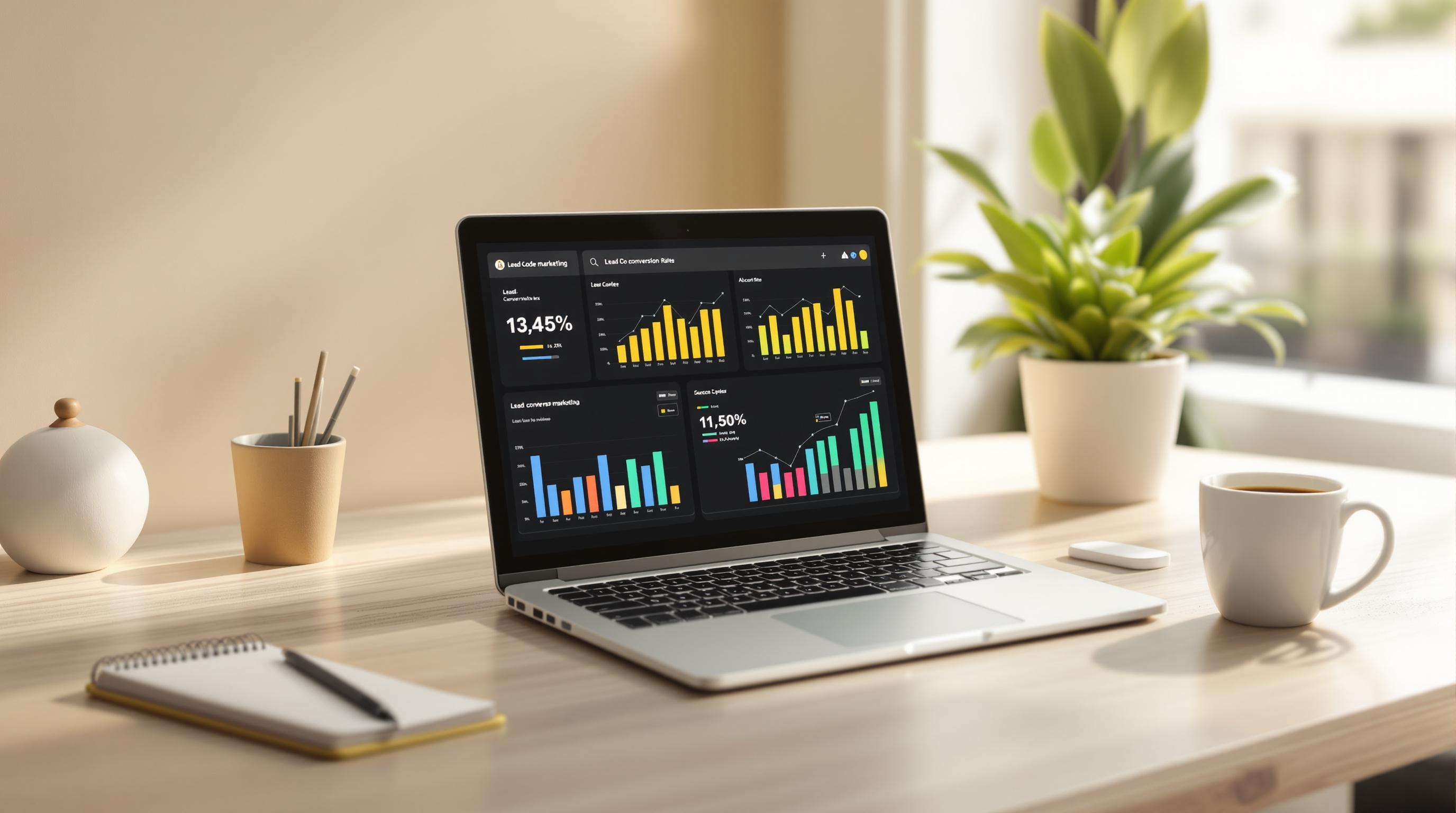Here’s why it matters:
- Only 23.4% of sales reps meet their quotas, and 54% struggle to find prospects.
- Tracking conversions shows which campaigns actually generate revenue.
- ROI benchmarks: 2:1 is below average, 5:1 is strong, and 10:1 is outstanding.
Key Takeaways:
- Metrics to track: Conversion Rate (CVR), Cost Per Lead (CPL), and Lead Quality Score.
- ROI Formula: (Revenue - Cost) / Cost x 100. Example: Spend $10,000, earn $50,000 = 400% ROI.
- Tools to use: Google Analytics, HubSpot, and no-code platforms like Wrapifai.
- Strategies to improve ROI: A/B testing, AI-powered lead scoring, and optimizing landing pages.
Ready to dive into the details and improve your lead conversion ROI? Let’s go!
Metrics to Track Lead Conversions
Key Metrics for Lead Conversion
To understand how well your business is converting prospects into customers, you need to focus on specific metrics. These numbers help you evaluate performance and fine-tune your strategies for better ROI.
Conversion Rate (CVR) is the starting point. Calculate it by dividing the number of successful conversions by total leads, then multiply by 100. For example, if you have 150 leads and 35 of them convert, your conversion rate is 23.3%.
Cost Per Lead (CPL) shows how efficiently you're generating leads. If you spend $1,000 on a campaign and it brings in 200 leads, your CPL is $5.
Lead Quality Score helps you assess how likely a lead is to convert based on factors like demographics or behavior. This allows you to focus on leads with the highest potential.
Here’s a look at average conversion rates for B2B SaaS companies at different funnel stages:
| Funnel Stage | Average Conversion Rate |
|---|---|
| Visitor to Lead | 1.4% |
| Lead to MQL | 41% |
| MQL to SAL | 39% |
| SAL to Opportunity | 42% |
| Opportunity to Customer | 39% |
Tracking these metrics gives you a clearer picture of your lead conversion performance and helps identify areas for improvement.
How to Set Up Lead Conversion Tracking
To track lead conversions effectively, you need the right tools and processes. Here’s how to set up a reliable system:
Google Analytics Setup
Define conversion goals in Google Analytics for key actions like form submissions or purchases. This provides a baseline for understanding user behavior.
"Focusing on these metrics alone can significantly improve your conversion rates", says Ivan Burban, Head of Marketing at Coupler.io.
CRM Integration
Connect your tracking systems to a CRM platform. This allows you to monitor the full customer journey, including metrics like lead response time, funnel duration, and source attribution. A CRM ensures you have a centralized view of all your leads and their progress.
Refining Tracking Accuracy
Combine data from multiple sources to improve accuracy. This helps you identify the most effective lead sources and allocate your budget more wisely, boosting ROI.
Research shows that companies with aligned teams and effective tracking systems are three times more likely to exceed customer acquisition goals. These businesses also grow 19% faster and see 15% higher profitability.
Steps to Calculate ROI for Lead Conversions
Basic ROI Calculation
Once you have the necessary metrics, you can calculate ROI to determine how effective your lead conversion strategies are.
The formula is simple: (Revenue - Cost) / Cost x 100.
Here’s an example: A software company spends $10,000 on a digital marketing campaign that generates 100 leads. Out of these, 10 leads convert into sales, each worth $5,000. The total revenue is $50,000. Using the formula:
($50,000 - $10,000) / $10,000 x 100 = 400% ROI
To ensure accurate ROI calculations, focus on tracking these three key elements:
| Component | Description | How to Track |
|---|---|---|
| Total Revenue | Money earned from converted leads | CRM sales data |
| Total Cost | All expenses tied to lead generation | Marketing and labor costs |
| Conversions | Leads that turn into customers | Conversion tracking tools |
While this formula works for straightforward campaigns, more intricate business models may need additional methods for measuring ROI.
Advanced ROI Methods
For businesses with recurring revenue or long sales cycles, basic ROI calculations might not capture the full picture. Advanced methods incorporate factors like customer lifetime value (CLV) and long-term revenue.
Here are some advanced approaches:
1. Customer Lifetime Value (CLV)
For subscription-based models, calculate CLV by multiplying the average monthly revenue per customer by their expected retention period (in months).
2. Adjusting for Sales Cycles
For B2B companies with extended sales cycles, use forecasted revenue based on:
- Historical conversion rates
- Average deal size
- Estimated time to close a sale
3. Multi-Touch Attribution
Account for the role of multiple marketing touchpoints in your ROI. This method assigns value to each stage of the customer journey, giving you a clearer understanding of your campaign's overall impact.
"AI and automation improve ROI calculations by delivering accurate, timely data for real-time campaign optimization", according to a recent analysis by MarketingCloudFX[3].
Top Tools for Tracking Conversions and Measuring ROI
Popular Tools for Conversion Tracking
Google Analytics is a go-to choice for 55% of marketers [2], thanks to its reliability in tracking conversions. HubSpot stands out by combining CRM and marketing automation, making it easier to link marketing activities directly to sales. Then there's MarketingCloudFX, which offers specialized features like phone conversion tracking through CallTrackerFX, giving users an edge in ROI analysis.
Comparing Free and Paid Tools
Here’s a quick look at how free tools like Google Analytics compare to paid options such as Adobe Analytics:
| Feature | Free Tools (e.g., Google Analytics) | Paid Tools (e.g., Adobe Analytics) |
|---|---|---|
| Initial Cost | $0 | Custom pricing, often $150,000+/year |
| Data Analysis | Basic reporting and insights | Advanced insights and predictive analytics |
| Real-time Monitoring | Limited | Full-scale monitoring capabilities |
| Integration Options | Basic | Broad ecosystem support |
| Support Level | Community-based | Dedicated customer service |
| Custom Reports | Limited | Highly customizable |
For businesses looking for simplicity, no-code platforms are becoming a practical alternative to traditional tools.
How No-Code Platforms Like Wrapifai Help

No-code platforms make tracking conversions and analyzing ROI easier than ever. Wrapifai, for instance, works alongside traditional tools by allowing businesses to build custom AI-driven tracking solutions - no coding skills required. Its features make it possible to monitor performance across various marketing channels effectively.
Some standout benefits include:
- Fast Setup: Get tracking systems up and running without waiting on developers.
- Custom Branding: Maintain a consistent user experience across all tracking points.
- Live Performance Data: Access real-time analytics to keep tabs on conversions.
Despite 80% of marketers focusing on ROI measurement, only 22% feel confident in their data's accuracy [1]. This highlights the need for tools that not only match business goals but also fit technical capabilities.
sbb-itb-c495ab1
Ways to Improve ROI from Lead Conversions
Tips to Boost Conversion Rates
To improve conversion rates, the first step is understanding what your customers need. Build detailed buyer personas and craft your content to match their preferences. High-converting pages often share these characteristics:
| Element | Best Practice | Impact on Conversion |
|---|---|---|
| Headlines | Clear value proposition above the fold | +20% conversion rate |
| Form Fields | Limit to 3-5 fields | +15% completion rate |
| Page Load Speed | Keep it under 3 seconds | +7% conversion rate |
| Mobile Optimization | Use responsive design | +25% mobile conversions |
| Social Proof | Add testimonials and trust badges | +12% conversion rate |
After optimizing your landing pages, use A/B testing to fine-tune these elements and push your conversions even higher.
Using A/B Testing to Improve Results
A/B testing is a powerful way to identify what resonates most with your audience. Test one variable at a time to get clear, actionable results. Here are some areas worth experimenting with:
- Call-to-action buttons: Try different designs and placements.
- Headlines: Test variations to see which grabs attention.
- Form fields: Adjust the number or arrangement.
- Social proof: Experiment with placement and types (e.g., testimonials vs. badges).
- Page layout: Play with visual hierarchy and overall design.
Run your tests for at least two weeks or until the results are statistically significant. While A/B testing is incredibly useful, AI and automation can add even more precision and efficiency to your optimization efforts.
Using AI and Automation to Increase ROI
AI tools can take your optimization strategy to another level by offering real-time insights and adjustments. For example, no-code platforms like Wrapifai allow businesses to integrate AI-powered tools easily, enhancing user engagement without technical hurdles. In one case study, a marketing firm saw a 30% increase in conversion rates after implementing AI-driven chatbots for personalized, real-time support.
Here’s how AI can boost ROI:
- Lead Scoring: Automatically rank and prioritize prospects with the highest potential.
- Content Personalization: Tailor messages based on user behavior and preferences.
- Conversion Path Optimization: Analyze and refine user journeys in real time.
- Performance Tracking: Use AI insights to monitor and adapt your strategies.
"The key to maximizing ROI is not just about generating more leads, but about converting those leads into customers." - Neil Patel, Digital Marketing Expert, NeilPatel.com
Summary and Next Steps
Key Takeaways from the Guide
Tracking lead conversions and calculating ROI are crucial for improving marketing performance. This guide has provided the tools you need to monitor conversions, measure ROI, and refine your strategies. By focusing on important metrics, using advanced tools, and incorporating AI-driven solutions, businesses can enhance both efficiency and profitability.
| Area | Key Components | Impact on ROI |
|---|---|---|
| Metrics | Lead volume, conversion rates, revenue per lead | Establishes a foundation for improvement |
| Tracking Setup | Google Analytics, MarketingCloudFX, Unbounce | Supports informed decision-making |
| ROI Analysis | Basic and advanced calculations, sales cycle length | Highlights most profitable channels |
| Optimization | A/B testing, AI tools, conversion rate improvement | Boosts return on investment |
HubSpot research highlights that businesses tracking their ROI consistently are 1.6 times more likely to improve marketing efficiency [1]. With these insights, you’re ready to take practical steps to increase your lead conversion ROI.
How to Start Improving ROI
Choose tracking tools that align with your business needs, ensuring all lead sources and costs are accurately monitored. Establish your current ROI baseline, then focus on high-impact areas using proven tactics:
| Strategy | Implementation | Expected Outcome |
|---|---|---|
| Lead Scoring | Focus on prospects with the most potential | More efficient use of resources |
| Sales Cycle Analysis | Analyze length and key conversion points | Improved ROI accuracy |
| AI Integration | Use tools to optimize conversions | Better user engagement and results |
"The key to maximizing ROI isn't just about tracking numbers - it's about understanding what those numbers mean for your business and taking action based on that insight." - HubSpot Marketing Analytics Report [1]
Sales Lead Conversion Rate: Formulas, Metrics, and Tricks for Making the Most of Every Lead
FAQs
Here are answers to some common questions about tracking lead conversions and calculating ROI to help you apply these concepts with ease.
What is the ROI of a lead source?
ROI for a lead source shows the financial return you get for every dollar spent on generating leads from a specific channel. For instance, if you invest $2,000 in an email marketing campaign and it generates $10,000 in revenue, your ROI would be 400%.
| Component | Description | Role in ROI Calculation |
|---|---|---|
| Revenue | Income from converted leads | Key factor in determining returns |
| Cost | Expenses for lead generation | Forms the baseline for calculations |
| Timeframe | Period of measurement | Ensures accurate performance tracking |
How do you calculate ROI for lead generation?
The formula for calculating ROI in lead generation is straightforward:
ROI = (Revenue - Cost) / Cost x 100%
For example, if a company spends $11,000 on marketing and earns $55,000 in revenue, the ROI would be 400% [2].
How to calculate ROI on leads?
To calculate ROI on leads effectively, focus on these key components:
- Revenue Generated: Measure the total income from converted leads.
- Lead Generation Costs: Include all expenses involved in acquiring leads.
- Conversion Data: Track how many leads turn into actual sales.
"The key to maximizing ROI isn't just about tracking numbers - it's about understanding what those numbers mean for your business and taking action based on that insight." - HubSpot Marketing Analytics Report [1]
For precise tracking, tools like Google Analytics or MarketingCloudFX can be helpful [3]. Also, keep your sales cycle length in mind to capture the complete revenue impact of your efforts. These insights can help fine-tune your strategies and improve ROI over time.


